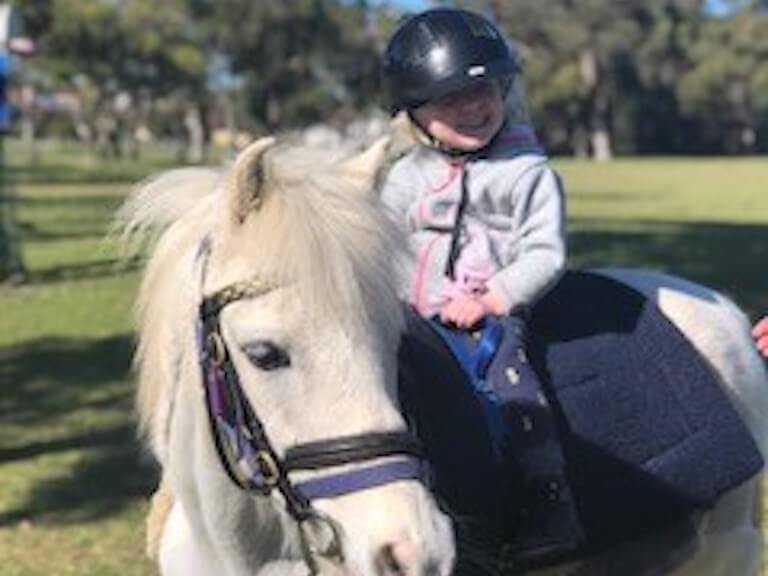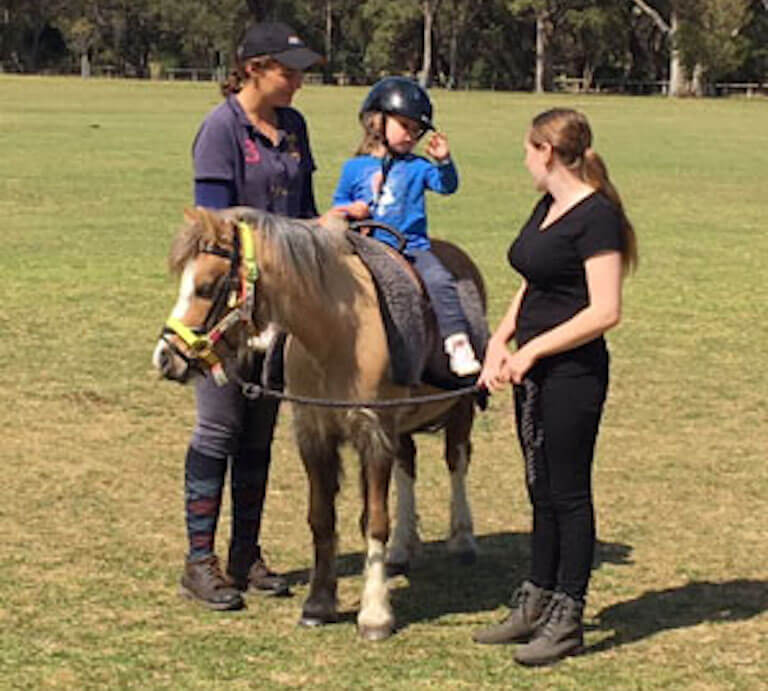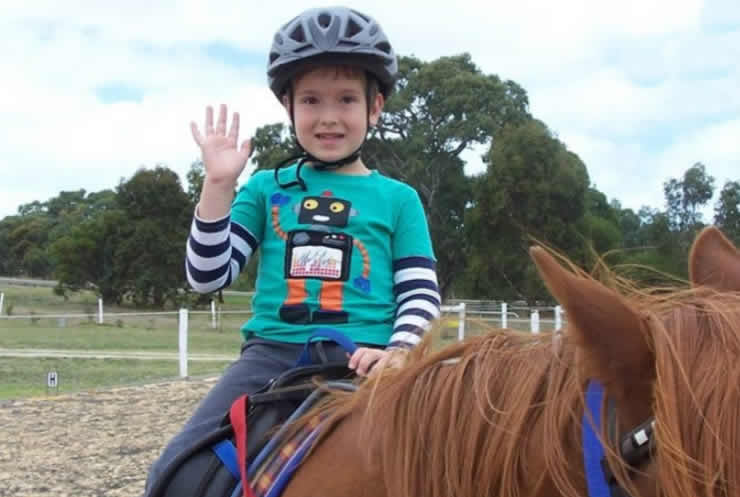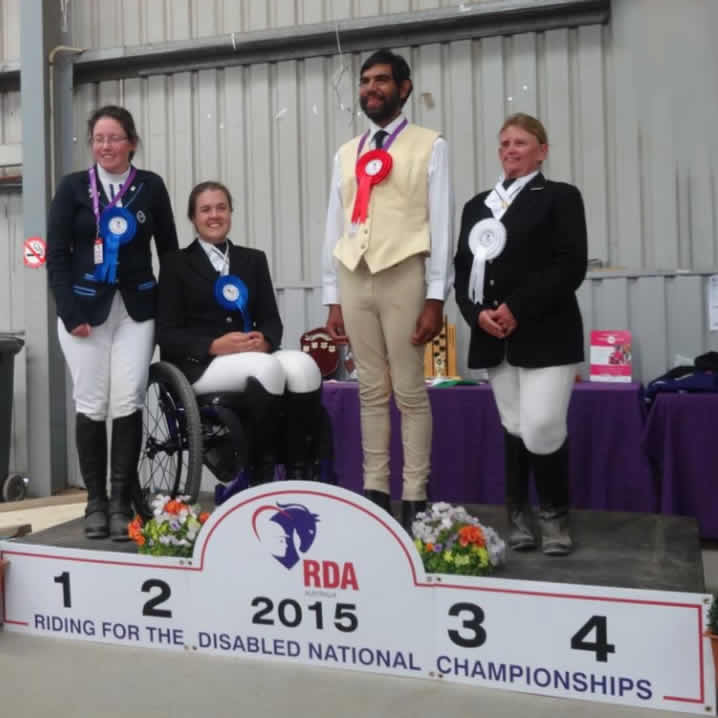I want to register as a Rider
Rider Experiences
Milly
Hi, I’m Milly! I’m four years old and I have Cerebral Palsy. To walk I need to wear Ankle-Foot Orthoses and use my walker, but when I’m riding I don’t need these things – I just need a bit of support from the Coach and volunteers at RDA Carine. I’ve been going to RDA Carine for about a year, but unfortunately, we can’t go at the moment because of coronavirus restrictions. Riding the ponies is a great way for me to get exercise and work on my balance and core strength. I always feel safe with volunteers beside me while I practice my riding skills. I miss the ponies and all the staff and volunteers so much! They do such a great job and I cannot wait to get back as soon as possible. Thank you to everyone that helps make RDA such a great place.

Ellie
Ellie is four years old and lives in Perth. She has a twin brother, Heath and they have both started kindy this year. Ellie’s favourite things are Emma Wiggle, Elsa and Anna from Frozen and baking. Ellie was diagnosed with Kabuki Syndrome at 18 months old. She has impaired vision, low muscle tone and some developmental delays. Ellie started at RDA Carine one year ago and absolutely loves it! Ellie was lucky enough to ride Dreamie for the last year who was such a wonderful horse for her. The Coaches put a lot of effort into finding the right horse for Ellie and you can see what a difference that makes. They are always great with explaining what they are doing and why. Ellie’s favourite coach is Emma. They have a very special bond and Ellie has learnt so much with her. Ellie was finding it particularly hard to learn colours but after some consistent and fun games with Emma, she knows and remembers them all now! The volunteers at RDA Carine are amazing as well, we are very luck to have such a great group there. Ellie often gets Joan and Cassie and she really enjoys seeing their familiar, patient faces every week. There role is quite involved and the work they do looking after both horse and rider is very much appreciated. We are really grateful to be able to have access to such a service and I don’t think it would be possible without such dedicated volunteers. Ellie started walking at two years old and was still struggling with stairs at three. Within in a couple of weeks of riding, her core strength and confidence has improved so much she started to walk (instead of crawl) on stairs! When we started at RDA, I thought the focus was mostly going to be on physical activities and improving posture and movement, but now it’s really a combination of physio, speech and OT all whilst on horseback. It really brings together everything that Ellie is working on and reinforces what she’s learning in a fun, caring environment.Mia Perrie
Mia’s journey with RDA started 8 years ago when she was 3 years old. She had just been given her diagnosis of Angelman Syndrome after 3 long years of searching for an answer.
Angelman Syndrome is a complex genetic disorder that primarily affects the nervous system and occurs in one in every 15,000 live births and affects both males and females.
Common characteristics of Angelman Syndrome are:
 developmental delay, intellectual disability and short attention span;
developmental delay, intellectual disability and short attention span; lack of speech or severe speech impairment;
lack of speech or severe speech impairment; seizures; disorders of walking and balance (ataxia);
seizures; disorders of walking and balance (ataxia); most children have a small head (microcephaly).
most children have a small head (microcephaly).


Tobias Meeks
Tobias has Spina Bifida which makes it difficult for him to walk properly. Spina Bifida is characterised by a defective closure of the vertebral (spinal) column. There is no cure for the condition and currently occurs in 1 in every 1000 pregnancies.
Tobias started at the RDA Victor Harbor Centre when he as 3 and a half years old and was recommended to his family by Novita Children’s Services to RDA.
At first he was a shy little boy who hardly spoke, but now he chatters away and gives good strong voice commands to his pony Rusty.
Tobias loves to trot a small distance, with support from his sidewalkers who always make sure he does not get too tired. Trotting, for short distances, improves core stability and balance. RDA allows for special adaptions to make horse riding effective depending on the different disabilities. For Tobias, he wears leg supports and a special helmet to protect his shunt for hydrocephalus. Red and blue reins aid learning concepts such as left (blue rein) and right (red rein) directionality.
His smile when he achieves a goal when playing a game is really very special.
Mercedes Portaro
Mercedes was born with Spina Bifida that resulted in altered sensation and severe weakness below her waistline. She was never expected to walk or even sit up straight but, under the recommendation from her physiother apist, she started horse riding with RDA at the age of 3. Her first lesson at RDA required a high level of support. There were many days where, even with his amount of support, the activity was too tiring for her and the coaches would lay her over the horse on her stomach for relaxation. The movement of the horse and constant approximation of muscle tone proved miraculous. Mercedes learnt to walk unaided and has a healthy love of physical exercise. She learnt to ride independently and compete in the Special Olympics, winning a gold medal in dressage. Mercedes loves the sport and has been a regular competitor at State and National Championships.

Ethan Satour
Ethan Satour made history at the RDA National Championships by being the first competitor from the Northern Territory. But that wasn’t all – it was a celebration of “21sts” at the Championships. It was the 21st RDA National Competition
It was the 21st RDA National Competition
 It was Ethan’s 21st birthday
It was Ethan’s 21st birthday
 It was Ethan’s horse, Ranger’s 21st birthday.
Ethan started with RDA Alice Springs 6 years ago as a rider with his school group and after finishing Year 12 he commenced a VET Certificate course in Horsemastership, completing his practical components through RDA. He is now a part time stable hand working at the RDA Alice Springs Centre. Ethan has competed in the NT School Sports Athletics competition and was a finalist in the Young Achiever Awards (NT). His goal for the future is to become an elite equestrian competitor.
Ethan, Ranger and the crew from Alice Springs made the remarkable 2,300km journey to Werribee, Victoria to participate in one dressage test. Once he was there, however, Ethan was persuaded to join in the Working Trails competition as well – and what a good decision as Ethan came 2nd in his class!
It was Ethan’s horse, Ranger’s 21st birthday.
Ethan started with RDA Alice Springs 6 years ago as a rider with his school group and after finishing Year 12 he commenced a VET Certificate course in Horsemastership, completing his practical components through RDA. He is now a part time stable hand working at the RDA Alice Springs Centre. Ethan has competed in the NT School Sports Athletics competition and was a finalist in the Young Achiever Awards (NT). His goal for the future is to become an elite equestrian competitor.
Ethan, Ranger and the crew from Alice Springs made the remarkable 2,300km journey to Werribee, Victoria to participate in one dressage test. Once he was there, however, Ethan was persuaded to join in the Working Trails competition as well – and what a good decision as Ethan came 2nd in his class!David Todd
The 2013 RDA National Championships has to go down as one of the best experiences of my life that capped off such an awesome year. I was recovering from losing both my wife of 21 years and my mother in 2012. I began volunteering at the RDA Officer Centre and was asked whether I wanted to ride, which I said yes to. Then with Mark McIntosh as my Coach, was encouraged and supported to enter both the State then the National competitions. As soon as I arrived in Werribee, I felt this was going to be a fabulous experience and was not let down. The people were all great and welcoming and, for a person who was never any good at sport, now competing in the National Championships was a dream I would have never even considered before joining RDA Officer. I loved the dress up at the BBQ dinner, then to top it off at the end, I was asked to carry the Victorian Flag at the Closing Ceremony; a great honour indeed that I accepted with great pride. Then the icing on the cake was winning the Willy Award for sportsmanship. Words could not describe the feelings I felt then and this has truly gone down as one of the most memorable and rewarding experiences of my life, hands down. Thanks for the support I have had from everyone from the RDA Officer Centre and, of course, the State Coaches and being asked to join the State Squad.
RDA Program Benefits

As the horse moves the rider is constantly thrown off balance, requiring the rider’s muscles to contract and relax in an attempt to rebalance. This exercising is similar to physiotherapy, reaching the deep muscles, but making the therapy more enjoyable and even fun! The three-dimensional rhythmic movement of the horse is similar to the motion of walking, teaching rhythmical patters to the muscles of the legs and trunk. By placing the rider in different positions on the horse (therapeutic riding) different muscles are worked. Stopping and starting the horse as well as changing the speed and direction increases the benefits.

Muscles are strengthened by the increased use involved in riding. Even though riding is exercise, it is perceived as enjoyment, therefore the rider has increased tolerance and motivation to lengthen the period of exercise.

Riding a horse requires a great deal of coordination in order to get the desired response from the horse. Since the horse provides instant feedback to every action from the rider, it is easy to know when you have given the correct cue. Repetition of the patterned movements required in controlling a horse quickens the reflexes and aids in motor planning.

Sitting on a horse requires stretching of the adductor muscles of the thighs. This is accomplished by pre-stretching exercises prior to mounting and by starting the rider on a narrow horse and gradually working to wider horses. Gravity helps stretch the calf muscles when the rider sits on the horse without stirrups. Stomach and back muscles are stretched by encouraging the rider to maintain an upright position against the movement of the horse. Arm and hand muscles are stretched by the act of holding the reins. The rhythmic motion and warmth of the horse aids in relaxation, particularly of the legs. Sitting astride the horse helps break the extensor spasms of lower limbs. Holding the reins helps to break the flexor spasm patterns of upper limbs. Fatigue helps to decrease spasticity by producing relaxation.

As spasticity is reduced, range of motion increases. Range of motion is also improved by the act of mounting and dismounting, tacking, grooming and exercises during the lesson.

Although riding is not normally considered a cardiovascular activity, trotting and cantering do increase both respiration and circulation.

Like all forms of exercise, riding stimulates the appetite.

Riding stimulates the tactile sense both through touch and environmental stimuli. The many sounds of the outdoor farm situation helps to involve the auditory system.
Sport and Recreation activities connect you to other people, are conducted outside of your home.
Meeting People Introductions Eye Contact Structuring a Two-Way Conversation How to talk about topics of interest
Although riding can be a solitary activity, it is normally performed in groups. Riders share a common love of horses and a common experience of riding, a good foundation on which to build a friendship.
The rider quickly learns self control Taking turns and sportsmanship Team work and working with others
Exercise in the fresh air of the country away from hospitals, doctors offices, therapy rooms, home helps to promote a sense of well being.
The excitement of riding encourages the rider to speak and communicate about their activities
Confidence is gained in mastering new skills normally performed by able-bodied people. The ability to control an animal much larger and stronger than oneself is a great confidence builder.
Before one can be taught to read, it is necessary to recognise the difference in shapes, sizes and colours. These can be taught on horseback in the form of games and activities. There is less resistance to learning when it is part of a horse riding lesson.
Counting is learned by counting the horses footfalls, objects around the arena etc. Because the concepts of maths are taught through games, the resistance to learning is less.
Something as simple as holding a pencil requires a great deal of motor planning. Knowing which comes first in a sequence of events is an important part of most activities. These and other skills are taught on horse back through the use of obstacle courses, pole bending and many other games and activities.
Eye and hand coordination is necessary for skills such as writing. These skills are taught in grooming and preparing the horse as well as other activities and exercises.
This includes our awareness of form and space and our understanding relationships between the forms in our environment. Included in this is directionality (knowing right from left), space-perception (knowing when items are close in shape but different), perception of depth (picking out an object from a background) and visual sequential memory (such as remembering patterns).
The rider learns to differentiate significant from less significant stimuli in the environment. An improvement in this area occurs as the rider learns to attend to their horse and those things that may influence the horse rather than attending to the environment in general.
In some large centres, the office offers the opportunity when possible for riders to gain practical knowledge and experience working in an office.